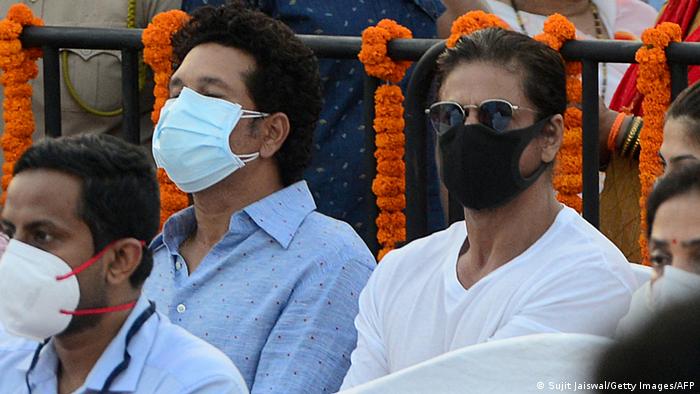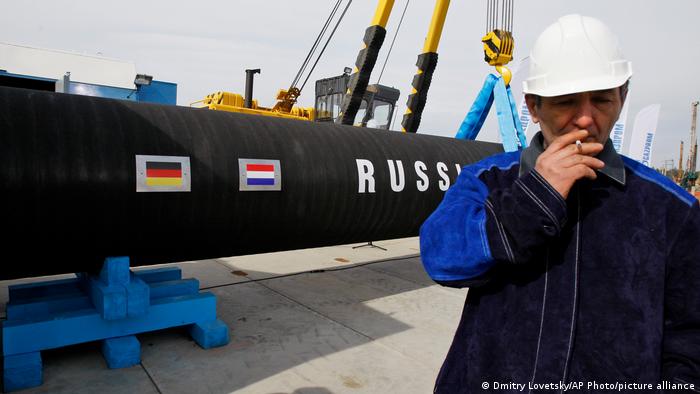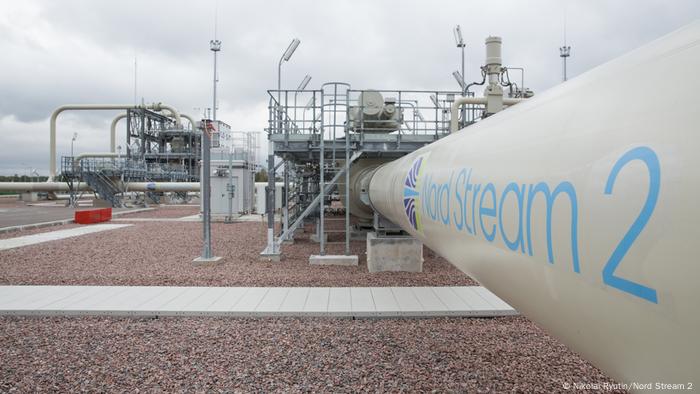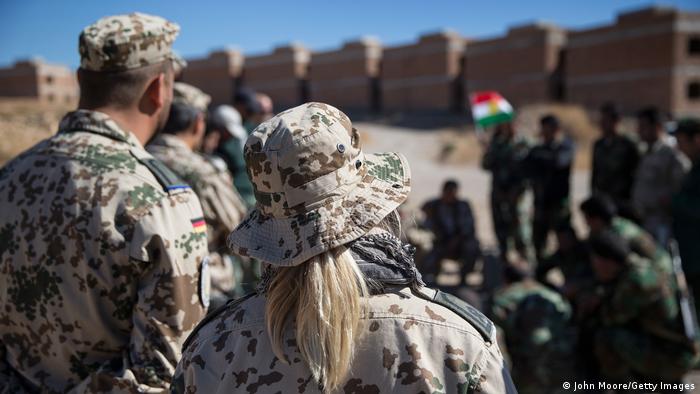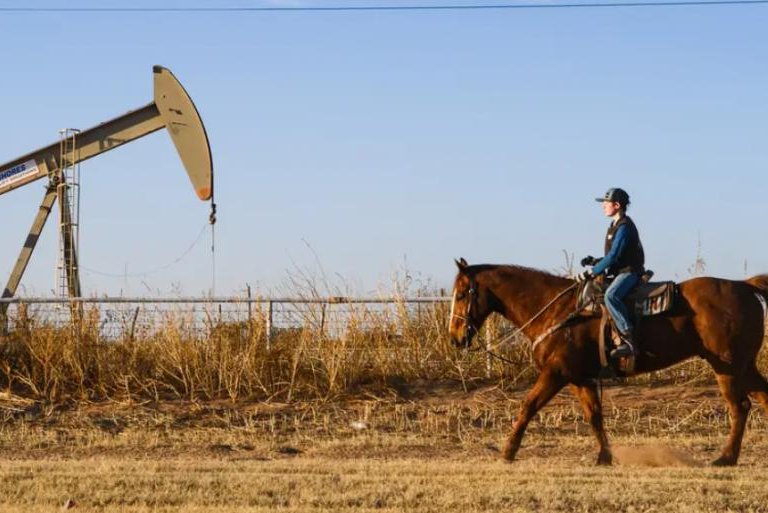In January, Gazprom CEO Alexey Miller said 2021 had been a record year for the Russian energy giant, both in terms of production and profits. Thanks to rising demand and the exploding cost of gas and oil, the company is raking in rubles.
It is the Russian state that controls most of the shares and decides on the company's direction. But various German firms, such as electric utility company E.ON, also own shares in Gazprom, which is the biggest producer of natural gas in the world. It has almost 500,000 employees and claims to hold the biggest gas reserves in Russia.
Miller is an old friend of Russian President Vladimir Putin, who almost always sits at the table of the supervisory board and the board of directors.
Gazprom is EU's biggest gas supplier
Gazprom's market power in Europe is the result of a monopoly. Russian legislation stipulates that only Gazprom is allowed to operate pipelines used for export. It has been the biggest supplier to the European Union (EU) for decades.
About 43% of the natural gas consumed in the EU comes from Russia, according to the EU statistical office Eurostat, while the rest comes from Norway, the Middle East, the US, and North Africa.
But within the EU, the market share of Russian gas varies widely in different member states. The rule of thumb is that the further east a country lies, the more likely it is to depend on Russia, and Germany, the EU's biggest energy consumer, draws about 55% of its gas from Russian energy giants.
"Gazprom uses its market power by influencing prices through the amount of gas that it supplies to Europe," energy expert Georg Zachmann from the Brussels-based Bruegel think tank told DW.
Competition between EU regulators and Gazprom
In the past 10 years, the EU has tried to establish a relatively unified gas market in the bloc by introducing regulations according to which Gazprom is supposed to supply gas to the external borders, which the member states can then trade.
Germany can buy gas in Russia and then sell it on to Poland or Ukraine. But it is in Gazprom's interest to conclude direct contracts with those receiving the gas, in order to keep dependency high.
"There is a kind of competition between the European regulators who are trying to create a market with unified prices and Gazprom which is trying to impose different prices in different countries," explained Zachmann.
While Gazprom insists that it has honored all its long-term supply commitments, Zachmann said that the company was actually supplying less gas to the market with short-term contracts.
Zachmann said that the short-term market had become increasingly important in recent years because there was an attempt to become less dependent on Gazprom in the long run.

A Gazprom subsidiary owns this storage facility in Germany
"Gazprom is fulfilling its contracts, that is true, but only at the lowest level of its commitments," European Commission President Ursula von der Leyen pointed out recently. She said that other suppliers had increased their deliveries in view of the rapidly rising demand and record prices.
Von der Leyen added that Gazprom was behaving in a strange way, considering that more gas was not being supplied despite high demand. She also told the German daily Handelsblatt that the fact that the company belonged to the Russian state raised doubts as to its reliability.
Gazprom has stakes in local and regional energy providers in almost all EU states. In Germany, for example, its subsidiary Astora owns the biggest underground gas storage facility in western Europe. Located in Rehden in Lower Saxony, it acts as a buffer when there are fluctuations in supply and demand.
Could Russia turn off the tap?
If Gazprom were to receive instructions from the Kremlin to stop supplying gas to the EU, there could be significant shortages.
Von der Leyen said that she did not believe it would come to that. Since the Russian economy is so dependent on energy exports, it would not make sense to jeopardize its relationship with its biggest client and investor.
But she told Handelsblatt that the EU and the US were working to increase supplies of liquefied natural gas from Qatar or the US. Negotiations are to take place this coming Monday in Washington DC.
Germany could become even more dependent on Russia
Energy expert Claudia Kemfert from the German Institute for Economic Research (DIW) predicted that the Nord Stream 2 pipeline, through which Gazprom will pump gas, would make Germany even more dependent on direct supplies from Russia.
"Europe has a strategy of diversifying gas purchases, whereas Germany chose the opposite path and further increased its reliance. This is now backfiring," she told DW.
In her opinion, the sale of gas storage facilities should not have been approved, or at the very least should have been regulated. She said that strategic reserves were needed for gas, just as they are for oil.
The EU is now considering building up such reserves and acting as a joint purchaser of gas, more than in the past, a strategy that Gazprom is trying to undermine by wooing individual member states. Hungary, for example, just signed an exclusive contract with Gazprom and will receive beneficial treatment regarding prices.

Former German Chancellor Gerhard Schröder has just joined the Gazprom Board of Directors
Zachmann is not optimistic that the EU can do much to oppose Gazprom's power: "You can negotiate as much as you want with a person who has all the leverage in their hand. If the gas tap can be shut off from Moscow, we are simply in a worse negotiating position."
For Miller, trade with Europe is only part of Gazprom's success. The company says it wants to become the world's leading energy company. After all, it not only trades in gas, but also in oil and it also produces electricity.
Meanwhile, President Putin has just unveiled a major gas deal with China at the start of the Winter Olympics in Beijing. The US is also a Gazprom customer and in 2020, 8% of the country's oil imports came from Russia, more than came from its ally Saudi Arabia.
This article was originally written in German.
Nord Stream 2: The gas pipeline's
second power struggle
The Nord Stream 2 gas pipeline, built to meet Germany's future power needs, is seen as controversial for allies like the US. The project faces renewed calls to be shelved amid a standoff between Russia and the West.
It's still unclear whether Nord Stream 2 will ever go into operation
What is Nord Stream 2?
Nord Stream 2 is the second natural gas pipeline running under the Baltic Sea from western Russia to northeastern Germany.
Along with its earlier cousin Nord Stream 1, which opened in 2011, the new pipeline has a transport capacity of 55 billion cubic meters of natural gas per year.
Nord Stream 2 cost €9.5 billion ($10.6 billion) to build and, at 1,230 kilometers long (764 miles), is the longest subsea pipeline in the world. First conceived more than a decade ago, construction began in May 2018 and was completed in September.
However, Nord Stream 2 has yet to begin pumping gas as its operating license has been delayed.
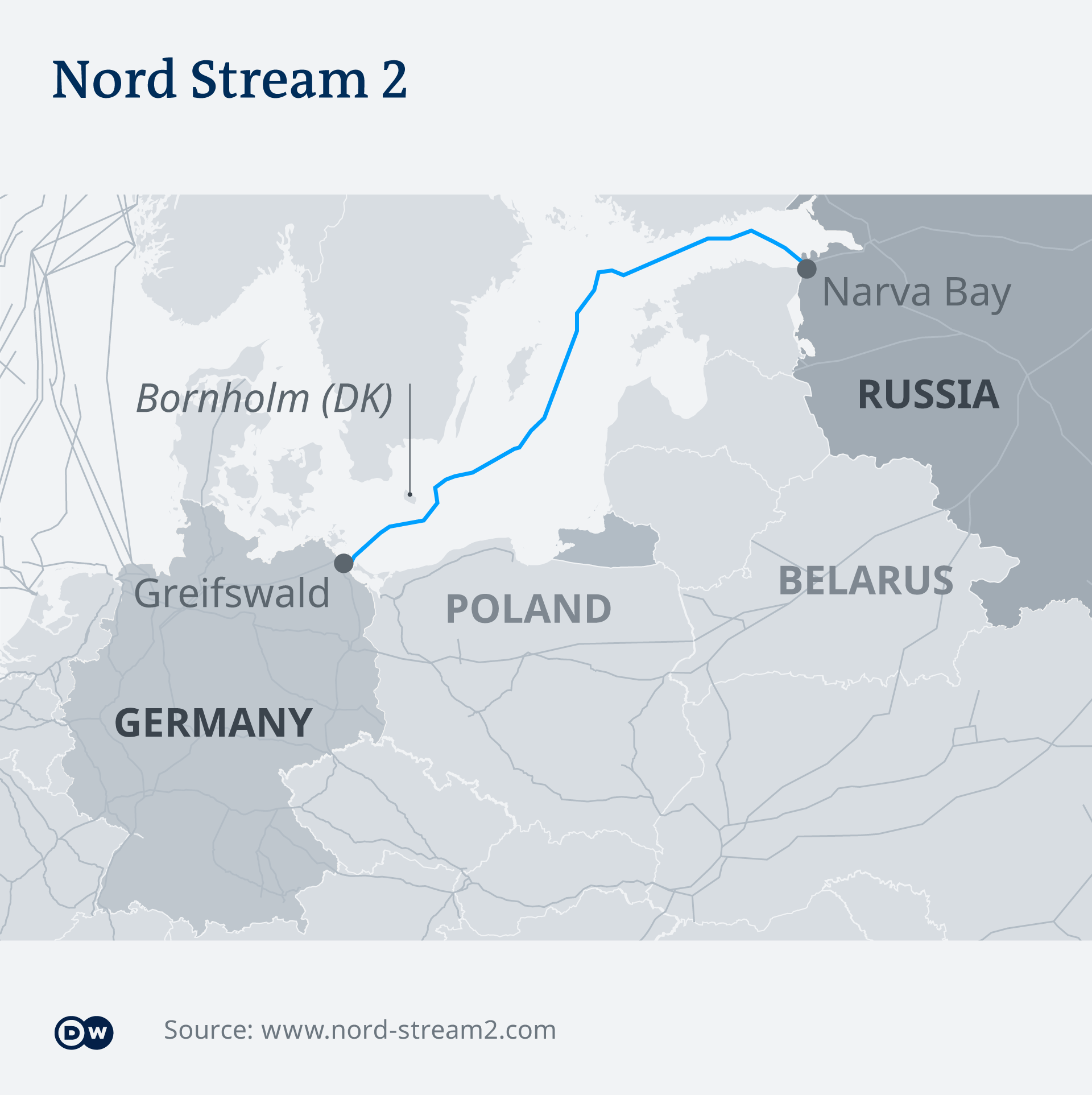
Why is Nord Stream 2 needed?
Germany is almost totally reliant on natural gas imports, with Russia accounting for more than half of supplies in 2020, according to IHS Markit.
Europe's No.1 economy needs to wean itself off coal and nuclear as part of its energy transition, and wants to use natural gas as a bridge until it can build or import enough renewable energy.
The need for gas has become more acute with the closing of three of Germany's six last remaining nuclear power stations last month. The final three will shut down in December.
While Nord Stream 2 will help Germany boost its supply, most of the natural gas will be piped to Austria, Italy and other Central and Eastern European nations.
Some environmental groups have insisted all along that the pipeline is unnecessary.
Who is involved in Nord Stream 2?
The pipeline belongs to the Russian state-owned company Gazprom and was built with the backing of five European energy firms.
They are: Austria's OMV, Britain's Shell, France's Engie, Germany's Uniper and the Wintershall unit of BASF.
The five companies put up around half of the initial investment.
Why is Nord Stream 2 so controversial?
The United States and several of Germany's European partners have been against Nord Stream 2 from the start and lobbied the government of former Chancellor Angela Merkel to back out of the deal.
The allies have warned that Nord Stream 2 would make Europe too reliant on Russian gas, which they say Russian President Vladimir Putin could use as leverage in disputes with the West.
Much of Europe's gas currently transits through Ukraine, which receives transit fees from Russia.
Poland disapproves of Nord Stream 2 as it, too, has sought to boost its role as a transit country for Russian gas.
Berlin has long insisted that the pipeline is purely an economic issue.
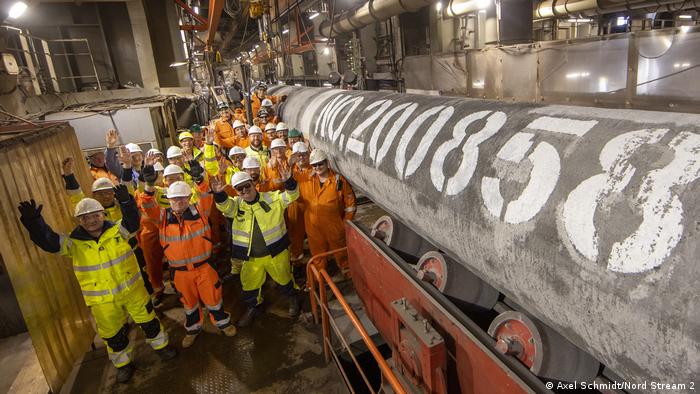
Workers celebrate the completion of Nord Stream 2 in September 2021
Why was Nord Stream 2 nearly shelved?
In 2018, as it was being built, then US President Donald Trump imposed sanctions on anyone involved in the construction of Nord Stream 2.
Some 18 European companies pulled out, including Germany's Wintershall, for fear of being hit by financial penalties.
Gazprom said it would continue laying the pipeline itself, and the project was completed anyway.
Last May, the Biden administration waived all sanctions against Nord Stream 2 so as not to strain relations with Germany.
Why is Nord Stream 2 again under threat?
The pipeline has now taken center stage during an escalating crisis between Russia and the West over Ukraine.
The US and NATO say Russia has amassed more than 100,000 troops at its border with Ukraine, ready to invade. Moscow has denied this.
The West has threatened to impose fresh sanctions on Moscow, this time targeting Russian banks.
One theoretical possibility is to exclude them from the SWIFT global payment system, which is responsible for 35 million daily financial transactions worth some $5 trillion (€4.4 trillion).
Another proposal is to further delay formal approval for Nord Stream 2 to begin operations as leverage to force Russia back from the brink of war.
The post-Merkel government is no longer ruling out shelving the pipeline project. But Europe is currently facing a winter energy crunch. Prices of natural gas have skyrocketed in recent months, and stockpiles in EU countries are at a five-year low.
US President Joe Biden on February 7 vowed to put a stop to Nord Stream 2 if Russia invades Ukraine, warning: "`We will bring an end to it."
Meanwhile, Germany's energy regulator recently said Nord Stream 2 is unlikely to win approval before the summer.
Edited by: Hardy Graupner
This story was originally published on January 31, 2022, and was updated on February 8, 2022, to reflect recent developments.

